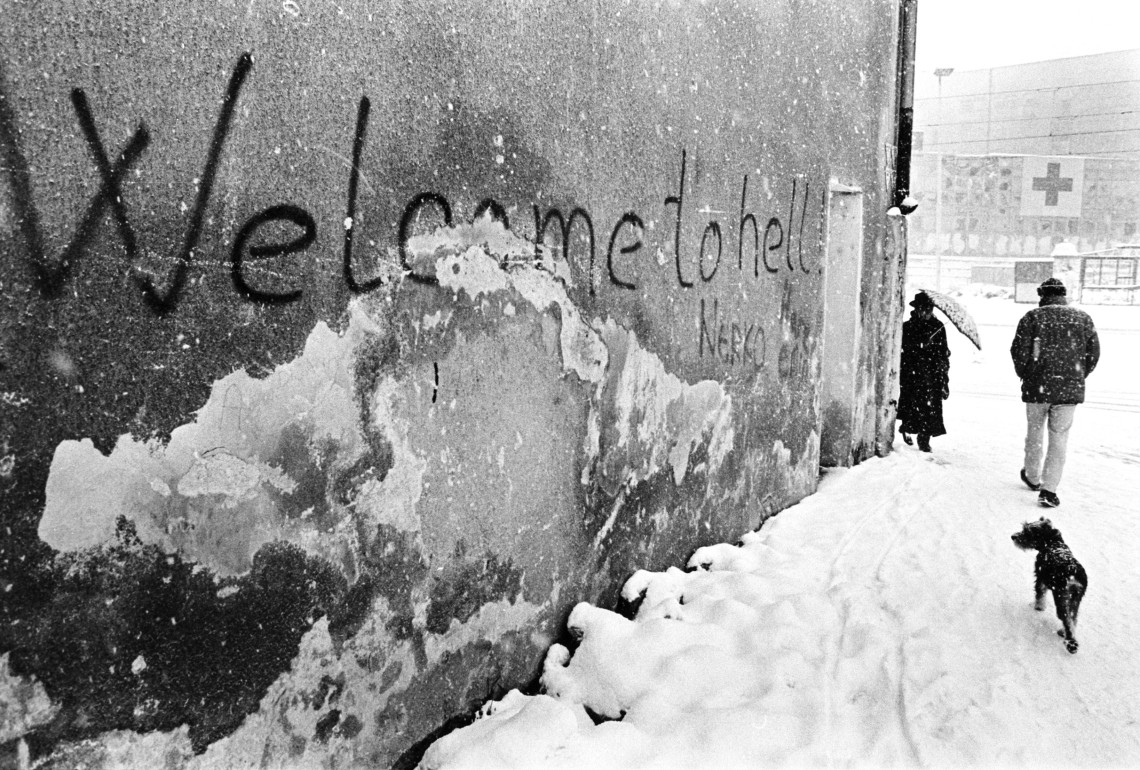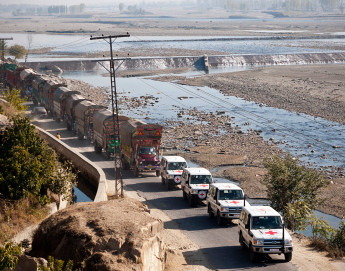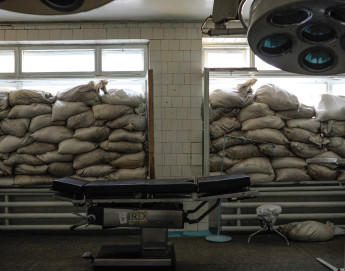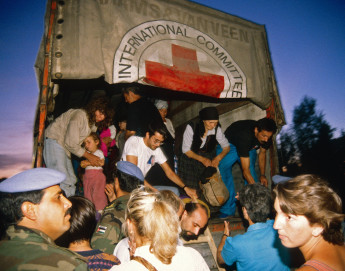
The protection of the civilian population during sieges: what the law says
What is a siege?
There is no definition of "siege" or "encirclement" under IHL. A siege can be described as a tactic to encircle an enemy's armed forces, in order to prevent their movement or cut them off from support and supply channels.
The ultimate aim of a siege is usually to force the enemy to surrender, and in contemporary conflicts besieging forces usually attempt to capture the besieged area through hostilities. Sieges or other forms of encirclement may also be part of a larger operational plan: for instance, they can be used to isolate pockets of enemy forces left behind during an invasion.
Recent sieges were accompanied by bombardment and sometimes intense fighting between besieging and besieged forces, creating constant danger for the civilians trapped in the besieged area. Little or no power and degraded public services are also characteristic features of sieges, in particular the collapse of hospitals and medical services, and of water treatment and sewage systems. Families are forced to make impossible choices with the little food and water available. Factors such as age, gender specific roles, or disabilities, may exacerbate difficulties in accessing scarce resources. The consequences are hunger, malnutrition, dehydration, illness, injury and death.
Are sieges prohibited under IHL?
Sieges may only be directed exclusively against the enemy's armed forces.
Unfortunately, civilians are often trapped within when entire towns or other populated areas are besieged, causing unspeakable suffering. IHL offers vital protection to these civilians by imposing limits to what the parties can do during such sieges. Crucially, civilians must be allowed to leave a besieged area, when it is required to spare them from the effects of military operations or when they lack the goods essential for their survival, including whenever a siege involves the use of starvation as a method of warfare.
Is the besieging party required to allow civilians to leave a besieged area?
Yes. Civilians must not be trapped in sieges, and both parties must allow civilians to leave the besieged area.
The Geneva Conventions contain essential, but limited, provisions on the evacuation (including by sea) of specific categories persons at specific risk, including wounded and sick, as well as certain civilians like persons with disabilities, older persons, children or pregnant women.
More broadly, today a besieging party may not force civilians to remain against their will in the besieged area.
IHL rules apply to the conduct of hostilities during sieges, in particular the principles and rules of distinction, proportionality and precautions. The implementation of several rules stemming from the principle of precautions requires both parties to allow civilians to leave the besieged area to escape hostilities whenever feasible. In particular, constant care must be taken to spare the civilian population in all military operations, and all feasible precautions must be taken, notably in the choice of means and methods of warfare, to avoid or minimize incidental loss of civilian life, injury to civilians and damage to civilian objects. In a besieged area where hostilities are taking place, and in view of the risk that this poses to them, one obvious precautionary measure is to evacuate civilians, or at least allow them to leave. Parties must also give effective advance warnings of attacks that may affect the civilian population, the purpose of which is precisely to enable civilians to take measures to protect themselves.
Shooting at or otherwise attacking civilians fleeing a besieged area would amount to a direct attack on civilians and is absolutely prohibited.
Can the besieging party use starvation as a method of warfare?
IHL prohibits the starvation of the civilian population as a method of warfare. Depriving civilians of supplies essential to their survival (such as food, water and medical supplies) in a besieged area cannot be used by a besieging party as a legitimate means to subdue its enemy.
Accordingly, sieges that have the purpose of starving the civilian population are prohibited, and a besieging party that uses starvation as a method of warfare against enemy forces must ensure that its effects are directed exclusively at those enemy forces. Using starvation as a method of warfare in a manner that indiscriminately also deprives civilians of supplies essential to their survival cannot be justified by asserting that its purpose was only to starve enemy forces. Whenever civilians are caught up in the besieged area, the besieging party must allow the civilians to leave the besieged area, because experience shows that in practice these civilians will share the privation caused by a siege and may be expected to be left with their basic needs unmet. If civilians nevertheless remain, the besieging party must comply with IHL rules on humanitarian relief to the civilians.
Does the besieged party also have obligations?
Yes, the besieged party has obligations, too. It must take all feasible precautions to protect the civilian population under its control from the effects of attacks. This can entail allowing civilians to leave or otherwise removing them from the vicinity of military objectives, for example by evacuating them from a besieged area where hostilities are ongoing or expected to take place.
The besieged party might be tempted to prevent the civilian population from leaving because having a besieged area cleared of civilians would make it easier for the besieging forces to starve out the besieged forces, or give the former more leeway when attacking military objectives in the besieged area. However, IHL categorically prohibits using the presence of civilians to render certain areas immune from military operations, for instance in attempts to impede the military operations of the besieging forces. This would amount to using the civilian population as human shields.
A besieged party which is not able to provide the supplies essential to the survival of the civilian population under its control must consent to humanitarian relief operations for civilians (see also below: What are the additional IHL rules to ensure the survival of the besieged civilian population and the rules on humanitarian relief?)
Can sieges be used to compel civilians to leave a particular area?
No. Although temporary evacuations may be necessary, and even legally required, sieges must not be used to compel civilians to permanently leave a particular area.
Civilians may flee a besieged or otherwise encircled area or be voluntarily evacuated; under very strict conditions, they may also be evacuated against their will by a party to the conflict. The issue of forcible evacuation of a besieged area has raised questions with respect to forced displacement. Under IHL, forced displacement is prohibited, unless the security of the civilians involved or imperative military reasons so demand.
To ensure that displacement is not forced or unlawful, it must be temporary and last no longer than the security of the civilians involved or imperative military reasons so demand. Displaced persons, whether they have fled or have been evacuated, have a right to voluntary return in safety to their homes or places of habitual residence as soon as the reasons for their displacement cease to exist. For instance, civilians displaced for their own security because of hostilities during a siege must be transferred back to their homes as soon as hostilities in the area in question have ceased.
Prohibited acts of forced displacement can include those resulting from unlawful acts under IHL by the parties to the conflict to coerce civilians to leave, including through unlawful conduct of hostilities. As hostilities during sieges entail a high risk of incidental civilian casualties, the security of the civilians involved may nonetheless require the parties to let civilians leave the besieged area.
Does IHL protect civilians leaving, or being evacuated from, a besieged area?
In all circumstances, IHL provides strong protections to civilians leaving, or being evacuated from, a besieged area.
From a practical perspective, safe evacuations are best organized when the parties to the conflict agree on the necessary procedures. In the absence of such an agreement, both parties remain obliged to take all feasible precautions to avoid causing incidental harm to civilians fleeing during hostilities.
In case of displacement, regardless of whether civilians flee or are evacuated from a besieged area, all possible measures must be taken to ensure that the civilians in question are received under satisfactory conditions of shelter, hygiene, health, safety (including from sexual and gender based violence) and nutrition and that members of the same family are not separated.
The besieging party may decide to screen displaced persons for security reasons, such as finding out whether members of the besieged forces intermingled with the civilians leaving the besieged area. Screening and other security measures undertaken by the besieging party must be conducted with full respect for IHL and international human rights law, particularly regarding humane treatment, living conditions and relevant procedural safeguards in cases of detention, and the prohibition against collective punishment.
Does IHL protect civilians remaining in a besieged or encircled area?
Civilians who remain in a besieged area continue to be protected as civilians, unless and for such time as they take a direct part in hostilities. The mere fact of remaining in a besieged area – whether voluntarily, forcibly, or as human shields – does not amount to taking a direct part in hostilities. In addition, the presence of besieged fighters among the civilian population does not mean that the civilians lose their protection from direct attack. The besieged and besieging forces therefore remain bound by all the rules protecting civilians against the effects of hostilities.
Furthermore, the IHL rules on starvation and on relief operations are designed to ensure – in combination – that civilians are not deprived of supplies essential to their survival.
What are the additional IHL rules to ensure the survival of the besieged civilian population and the rules on humanitarian relief?
First, in addition to the prohibition against using starvation of the civilian population as a method of warfare, IHL prohibits attacking, destroying, removing or rendering useless objects indispensable to the survival of the civilian population. Even when such objects are also used by the enemy armed forces, operations against them are prohibited if they can be expected to leave the civilian population with such insufficient quantities of food or water as to cause its starvation.
Second, during a siege, the parties continue to be bound by IHL obligations relating to relief operations and humanitarian access. IHL provides that impartial humanitarian organizations have a right to offer their services to carry out humanitarian activities, in particular when the needs of the population affected by the armed conflict are not being met. Once impartial humanitarian relief operations have been agreed to, the parties to the armed conflict – which retain the right to control the humanitarian nature of relief consignments – must allow and facilitate rapid and unimpeded passage of these relief operations.
A besieged party which is not able to provide the supplies essential to the survival of the civilian population under its control must consent to humanitarian relief operations for civilians. Similarly, a besieging party must allow humanitarian access to and relief operations for civilians remaining in the besieged area. This is subject to the parties' right of control and ability to impose temporary and geographically limited restrictions required by military necessity at the time and place of on going hostilities.
Under IHL, the parties that have to allow and facilitate humanitarian relief also have a right to impose measures of control. These measures may serve a number of purposes: they may allow parties to an armed conflict to assure themselves that relief consignments are exclusively humanitarian; they may prevent humanitarian relief convoys from being endangered or from hampering military operations; and they may ensure that humanitarian relief supplies and equipment meet minimum health and safety standards. Measures of control must be made in good faith and cannot result in unduly delaying or rendering impossible the delivery of the humanitarian relief.
Does IHL protect the wounded and sick in a besieged or encircled area?
Yes, IHL contains extensive rules relating to respect and protection for the wounded and sick, as well as the persons and objects assigned to care for them.
The Geneva Conventions contain a few explicit provisions on the evacuation of the wounded and sick from besieged areas and the passage of medical personnel and medical equipment into such areas (e.g (Art. 15 GC I, Art. 18 GC II and Art. 17 GC IV). More generally, parties must take all possible measures to search for, collect and evacuate the sick and wounded, and must provide – to the fullest extent practicable and with the least possible delay – the medical care and attention required by their condition.
All these rules apply not only to wounded and sick civilians; they also benefit wounded and sick members of an enemy's armed forces.
Finally, the wounded and sick, medical staff, health establishments and units - including hospitals – and means of transport must not be attacked or otherwise prevented to carry out their medical function. This specific protection can only exceptionally be lost and under very stringent conditions. For more details on the protection of hospitals during armed conflicts, including sieges, see: The protection of hospitals during armed conflicts: What the law says.
Does ICRC become involved in evacuations from besieged or encircled areas?
Any initiative that gives civilians a respite from violence and allows them to voluntarily leave for safer areas is a welcome one.
As a neutral and impartial humanitarian intermediary, the ICRC may help facilitate the safe passage of civilians out of besieged areas once the parties have reached an agreement. Such measures must be well planned and implemented with the agreement of the parties to the conflict and must ensure the safety of the evacuees and humanitarian personnel (see above Does IHL protect civilians leaving, or being evacuated from, a besieged area?).
Notwithstanding the agreement of the parties, safe passage operations remain hazardous operations. They encompass major risks for the affected populations and the humanitarian personnel involved. These risks must be managed in a way to minimise the potential damages for all the stakeholders. Over the past few decades, safe passage operations have saved the lives of hundreds of thousands of people.
As a humanitarian organization, the ICRC never helps organize or carry out forced evacuations. (see also above Can sieges be used to compel civilians to leave a particular area?) This applies everywhere we work. We do not take part any operation against people's will, our fundamental principles, or international humanitarian law.
For more details on how safe passages or humanitarian corridors work to help people in conflict zones, including sieges, see: How humanitarian corridors work to help people in conflict zones.




